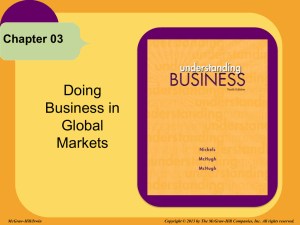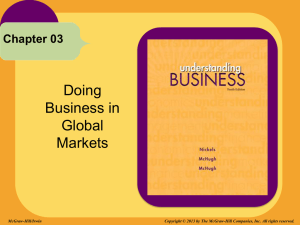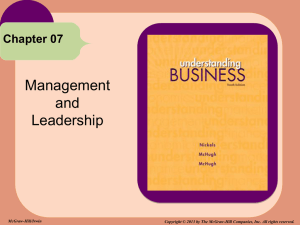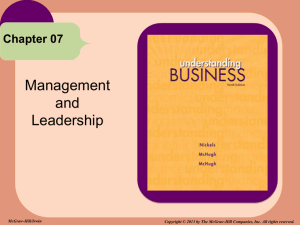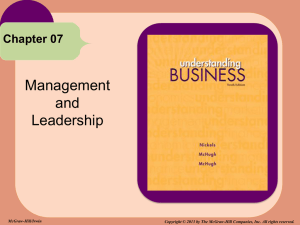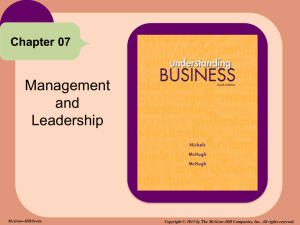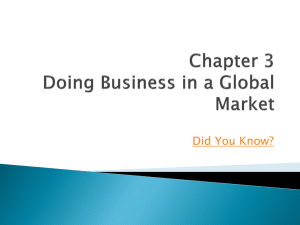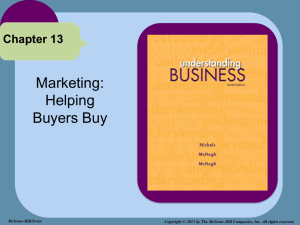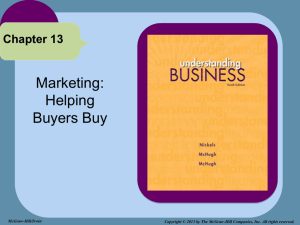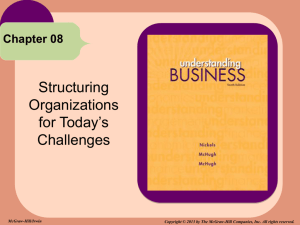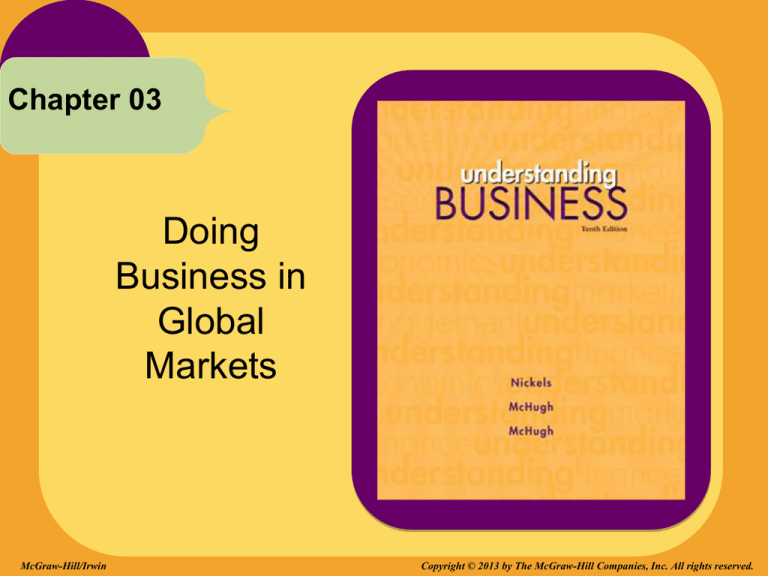
Chapter 03
Doing
Business in
Global
Markets
McGraw-Hill/Irwin
Copyright © 2013 by The McGraw-Hill Companies, Inc. All rights reserved.
Chapter Three
LEARNING GOALS
1. Discuss the importance of the global market and
the roles of comparative advantage and absolute
advantage in global trade.
2. Explain the importance of importing and exporting,
and understand key terms used in global business.
3. Illustrate the strategies used in reaching global
markets and explain the role of multinational
corporations.
3-2
Chapter Three
LEARNING GOALS
4. Evaluate the forces that affect trading in global
markets.
5. Debate the advantages and disadvantages of trade
protectionism.
6. Discuss the changing landscape of the global
market and the issue of offshore outsourcing.
3-3
The Dynamic
Global Market
LG1
BUSINESS in the
GLOBAL MARKET
• Over 90% of companies
doing business globally
believe it is important
for employees to have
international
experience.
• U.S. organizations (like
UPS, MLB, the NFL and
the NBA) are also
expanding abroad.
3-4
The Dynamic
Global Market
LG1
WORLD POPULATION
by CONTINENT
3-5
The Dynamic
Global Market
IMPORTING and EXPORTING
LG1
• Importing -- Buying products
from another country.
• Exporting -- Selling products
to another country.
• The U.S. is the largest
importing and the third
largest exporting nation in the
world.
3-6
Why Trade With
Other Nations?
WHY TRADE with OTHER NATIONS
LG1
1. No nation can produce all that it needs
2. Other nations need to trade in order to meet
their needs; mutually beneficial exchange
3. Some nations have less natural Resources and
more Technology, or vice-versa
3-7
Why Trade With
Other Nations?
LG1
TRADING with OTHER NATIONS
For Example:
• Countries with abundant natural resources (like
Venezuela or Russia) need technological
resources from other countries (like Japan).
• Global trade allows countries to produce what
they make best and buy what they need from
others.
• Free Trade -- The movement of goods and
services among nations without political or economic
barriers.
3-8
Why Trade With
Other Nations?
LG1
HOW FREE TRADE
BENEFITS the WORLD
Global trade has led the world in a new direction:
Literacy rates worldwide have increased from
56% in 1950 to 89% in 2011.
Life expectancy in less developed areas rose
from 40.9 years in 1950 to 69 years in 2011.
Source: The World Bank, June 2011.
3-9
The Theories of
Comparative and
Absolute Advantage
LG1
COMPARATIVE and ABSOLUTE
ADVANTAGE
Comparative Advantage: A country should sell
the products it produces most efficiently and buy
from other countries the products it cannot. For Ex.
United States: Software and engineering
Absolute Advantage: A country has a monopoly
on producing a specific product or is able to produce
it more efficiently than all other countries. For Ex.
South Africa : Diamonds
3-10
Getting Involved
in Global Trade
LG2
GOING GLOBAL with a
SMALL BUSINESS
• Small businesses may be the key in global
job growth.
• Only 1% of U.S. small businesses export, yet
they account for 30% of total U.S. exports.
• President Obama
wants small
businesses to help
double exports by
2015.
3-11
Getting Involved
in Global Trade
LG2
TRAITS NEEDED
FOR GOING GLOBAL
• Observation
• Determination
• Risk
3-12
Importing Goods
and Services
LG2
GETTING INVOLVED in
IMPORTING
• Students abroad may notice products that they
like are unavailable in their new country.
• By working with producers in their own country,
they become importers while still in school.
• Starbucks CEO, Howard Shultz, found his
importing opportunity in Italy. He
transformed a coffee shop in
Seattle to mimic European cafes.
3-13
Exporting Goods
and Services
LG2
GETTING INVOLVED in
EXPORTING
• Exporting provides a
great boost to the U.S.
economy.
• It is estimated that
every $1 billion in U.S.
exports generate over
7,000 U.S. jobs.
3-14
Measuring
Global Trade
HOW to MEASURE GLOBAL TRADE
LG2
• Balance of Trade -- The total value of a nation’s
exports compared to its imports measured over a
particular period.
• Trade Surplus (Favorable) -- When the value of
a country’s exports is more than that of its imports.
• Trade Deficit (Unfavorable) -- When the value of
a country’s exports is less than that of its imports.
3-15
Measuring
Global Trade
BALANCE of PAYMENTS
LG2
• Balance of Payments -- The difference between
money coming into a country (from exports) and
money leaving the country (from imports) plus other
money flows.
• The goal is to have more money flowing into a
country than out – a favorable balance.
• An unfavorable balance is when more money
flows out of a country.
3-16
Measuring
Global Trade
UNFAIR TRADE PRACTICES
LG2
• Dumping -- Selling products in a foreign country at
lower prices than those charged in the producing
country.
Used to reduce surplus products
Or to enter new markets
• Dumping is prohibited.
• China, Brazil and Russia have been penalized
for dumping steel in the U.S.
3-17
Strategies for
Reaching Global
Markets
LG3
Licensing
Least
KEY STRATEGIES for REACHING
GLOBAL MARKETS
Exporting
Franchising
Contract
Manufacturing
International
joint ventures
and strategic
alliances
Amount of commitment, control, risk and profit potential
Foreign
direct
investment
Most
3-18
Licensing
LICENSING
LG3
• Licensing -- When a firm (licensor) provides the
right to manufacture its product or use its trademark
to a foreign company (licensee) for a fee (royalty).
• Licensing can benefit a firm by:
- Gaining revenues it wouldn’t have otherwise
generated.
- Spending little or no money to produce or market
their products.
3-19
Exporting
LG3
EXPORT ASSISTANCE CENTERS
and EXPORT TRADING CENTERS
• EACs provide hands-on exporting assistance
and trade-finance support for small and mediumsized businesses that wish to directly export
goods and services.
• ETCs help companies engage in indirect
exporting by:
- Matching buyers and sellers.
- Dealing with foreign customs offices,
documentation, and conversions.
3-20
Franchising
FRANCHISING
LG3
• Franchising -- A contractual agreement whereby
someone with a good idea for a business sells
others the rights to use the name and sell a
product/service in a given area.
• Franchisors need to be careful to adapt their
product to the countries they serve.
• Yum! Brands, home of KFC, Taco Bell and Pizza
Hut, learned that food preferences differ all
around the world.
3-21
GOLDEN ARCHES GLOWING
ACROSS the GLOBE
(Reaching Beyond Our Borders)
• McDonald’s has more than 32,000 restaurants in
over 117 countries.
• Maintains varying menus around the world due to
the different preferences of its customers.
• Attracts top-level college
graduates to be trained
for management spots.
• Only 8 of every 1,000
applicants actually
makes it into the
program!
3-22
Franchising
MCDONALDS !!!
LG3
• Malaysia: Bubur Ayam McD – Chicken strips in porridge
with onions, ginger, and shallots.
• Egypt: Mcarabia – Grilled chicken with tehina sauces,
lettuce, tomato and onion on Arabic bread.
• Japan: Teritama – Teriyaki burger topped with an egg.
• Germany: Want a beer with your burger? You can order
one in the German stores.
• Israel: Operates using Kosher kitchens.
Source: McDonalds, www.mcdonalds.com, June 2011.
3-23
Contract
Manufacturing
CONTRACT MANUFACTURING
• Contract Manufacturing -- A foreign company
produces private-label goods to which a domestic
company then attaches its own brand name or
trademark. A form of outsourcing.
• Contract manufacturing can be used to:
- Allow a company to experiment in a new market
without incurring heavy start-up costs such as
building a manufacturing plant.
- Temporarily meet an unexpected increase in
orders.
3-24
International Joint
Ventures and
Strategic Alliances
JOINT VENTURES
LG3
• Joint Venture -- A partnership in which two or more
companies join to undertake a major project.
• The benefits of joint ventures:
- Shared technology and risk.
- Shared marketing and management expertise.
- Entry into markets where foreign companies are
often not allowed unless goods are produced
locally.
3-25
International Joint
Ventures and
Strategic Alliances
STRATEGIC ALLIANCES
LG3
• Strategic Alliance -- A long-term partnership
between two or more companies established to help
each company build competitive market advantages.
• Strategic alliances
don’t typically share
costs, risks,
management or profits.
• Strategic alliances
provide broad access
to markets, capital and
technical expertise.
3-26
Foreign Direct
Investment
FOREIGN DIRECT INVESTMENT
LG3
• Foreign Direct Investment (FDI) -- The buying of
permanent property and businesses in foreign
nations.
• Foreign Subsidiary -- A company owned in a
foreign country by another company called the parent
company. The most common form of FDI.
- Primary Advantage: Parent company maintains
complete control over its technology or
expertise.
- Primary Disadvantage: Must commit funds and
technology within foreign boundaries.
3-27
Foreign Direct
Investment
MULTINATIONAL CORPORATIONS
LG3
• Multinational Corporation -- A company that
manufactures and markets products in many
different countries and has multinational stock
ownership and management.
• Note: Not all large global businesses are
multinational. Only firms that have manufacturing
capacity or some other physical presence in
different nations can truly be multinational.
3-28
Foreign Direct
Investment
SOVEREIGN WEALTH FUNDS
LG3
• Sovereign Wealth Funds (SWFs) -- Investment
funds controlled by governments holding large
stakes in foreign companies. (Ch. 18)
• The size of the funds and the fact that they are
government-owned make some fear they might
be used for:
-
Geopolitical objectives.
Gaining control of strategic natural resources.
Obtaining sensitive technologies.
Undermining the management of the companies in
which they invest.
3-29
Forces Affecting
Trading in Global
Markets
LG4
FORCES AFFECTING
GLOBAL TRADE (Ch. 1)
1. Socio-cultural
2. Economic and
Financial
3. Legal and
Regulatory
4. Physical and
Environmental
3-30
Socio-cultural
Forces
1-CULTURAL DIFFERENCES
LG4
• To be involved in global trade, you must be
aware of the cultural differences among nations:
-
Social Structures
Religion
Manners
Values
Language
Personal Communication
3-31
Sociocultural
Forces
LG4
LOST in TRANSLATION
Advertisements Gone Wrong
• Braniff Airlines’ slogan "Fly in leather”
translated in Spanish as "Fly naked.”
• Siri, Apple’s new digital assistant on iPhone 4S,
is a common slang term for “butt” in Japanese.
• In Italy, Schweppes Tonic Water was mistaken
as Schweppes Toilet Water.
• Nokia’s line of Lumia phones is Spanish for
“prostitute.”
3-32
Sociocultural
Forces
LG4
READY to TRAVEL ABROAD?
Know Your Cultural Differences
• In Turkey, it’s rude to cross your arms while facing
someone.
• In many Middle Eastern countries, you shouldn’t eat
or shake hands with the left hand because it is
considered unclean.
• In India, you should never pat anyone’s head. It’s
where one’s soul is kept.
• In Brazil, your meeting may not start on time because
punctuality isn’t important to the culture.
3-33
Economic and
Financial Forces
LG4
2-ECONOMIC & FINANCIAL
Exchange Rates
• Exchange Rate: The value of one nation’s currency
relative to the currencies of other countries.
• High value of the dollar: Dollar is trading for more
foreign currency; foreign goods are less expensive.
• Low value of the dollar: Dollar is trading for less
foreign currency; foreign goods are more expensive.
• Floating Exchange Rate: Currencies “float” in value
depending on the supply and demand
for them in the global market.
3-34
Economic and
Financial Forces
LG4
2-ECONOMIC & FINANCIAL
Devaluation/Countertrading
• Devaluation -- Lowers the
value of a nation’s
currency relative to
others.
• Countertrading -Complex form of
bartering in which several
countries each trade
goods or services for
other goods or services.
3-35
Legal and
Regulatory
Forces
3-LEGAL CONCERNS OVERSEAS
LG4
• No global system of laws; laws are inconsistent
• U.S. businesses must follow U.S. laws while
conducting global business
• Organization for Economic Cooperation and
Development (OECD) and Transparency Int’l
fight to end corruption/bribery in foreign markets
• Little has been accomplished
3-36
Physical and
Environmental
Forces
4-ENVIRONMENTAL FORCES
LG4
• Developing countries
have transportation and
storage systems that
make international
distribution difficult or
impossible.
• Often, technological
capabilities are far from
those in the U.S. which
make for a tough
business environment.
3-37
Trade
Protectionism
TRADE PROTECTIONISM
LG5
• Trade Protectionism -The use of government
regulations to limit the
import of goods and
services.
• Advocates of protectionism
believe it allows domestic
producers to survive, grow
and produce jobs.
3-38
Trade
Protectionism
TARIFFS
LG5
• Tariffs -- Taxes on imports,
making imported goods more
expensive.
• Two kinds of tariffs:
-
-
Protective – Raise the
retail price of imports so
domestic goods are
competitively priced.
Revenue – Raise money
for governments.
3-39
Trade
Protectionism
IMPORT QUOTAS and EMBARGOS
LG5
• Import Quota -- Limits the number of products in
certain categories a nation can import.
• Embargo -- A complete ban on the import or export
of a certain product or the stopping of all trade with a
particular country.
• Political disagreements can
lead to embargos, like the
U.S. embargos against Cuba,
Iran and North Korea.
3-40
The World Trade
Organization
WORLD TRADE ORGANIZATION
LG5
• General Agreement on Tariffs and Trade
(GATT) -A global forum for reducing trade restrictions on
goods, services, ideas and cultural problems.
• World Trade Organization (WTO) -Headquartered in Geneva, the WTO is an
independent entity of 153 member nations whose
purpose is to oversee cross-border trade issues and
global business practices.
3-41
Common
Markets
COMMON MARKETS
LG5
• Common Market -- A regional group of countries
with a common external tariff, no internal tariffs and
coordinated laws to facilitate exchange among
members.
• The European Union (EU), Mercosur, the ASEAN
and the COMESA are common markets.
3-42
Common
Markets
EU MEMBERS
LG5
3-43
The North
American and
Central American
Free Trade
Agreements
NAFTA
LG5
• North American Free Trade Agreement -Ratified in 1994, created a free-trade area among
the United States, Canada and Mexico.
• NAFTA’s objectives are:
1) Eliminate trade barriers and facilitate cross-border
movement of goods and services.
2) Promote conditions of fair competition.
3) Increase investment opportunities.
4) Provide effective protection and enforcement of
intellectual property rights.
5) Establish a framework for further regional trade
cooperation.
6) Improve working conditions in North America.
3-44
The North
American and
Central American
Free Trade
Agreements
CAFTA
LG5
• Central American Free Trade Agreement -Passed in 2005, created a free-trade zone with Costa
Rica, Dominican Republic, El Salvador, Guatemala,
Honduras and Nicaragua.
3-45
The North
American and
Central American
Free Trade
Agreements
LG5
NEW FREE
TRADE AGREEMENTS
• Today, free trade
agreements are being
negotiated with South
Korea, Colombia and
Panama.
• The U.S. is considering
an agreement with a
nine-nation free trade
bloc called the TransPacific Partnership.
3-46
The Future of
Global Trade
FUTURE of GLOBAL TRADE
LG6
• With over 1.3 billion people, China has
transformed the world economic map. Many
multinationals invest heavily in China.
• India has seen huge growth in information
technology, pharmaceuticals and biotechnology.
• Russia is a large oil producing country with many
multinationals interested in developing there.
• Brazil is expected to be one of the wealthier
economies by 2030.
3-47
The Challenge
of Offshore
Outsourcing
OUTSOURCING
LG6
• Outsourcing -- Process by which a firm contracts
with other companies to do some or all of its
functions.
• U.S. firms have outsourced payroll functions,
accounting and manufacturing for years.
• With the growth of global
markets, companies have
been shifting to offshore
outsourcing – outsourcing
with other countries.
Photo Courtesy of: Vitor Lima
3-48
Globalization
and Your Future
PLAN for YOUR GLOBAL CAREER
LG6
• Study foreign
languages.
• Learn about
foreign cultures.
• Take global
business courses.
3-49
Progress
Assessment
IN CONCLUSION
• How has the Internet impacted doing business in
global markets?
• What are the economic risks of doing business in
countries like China?
• What might be some important factors that will
have an impact on global trading?
• What are pros and cons of offshore outsourcing?
3-50

